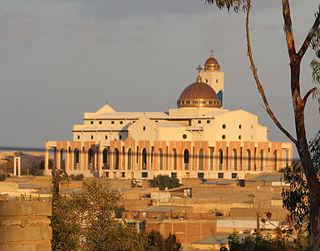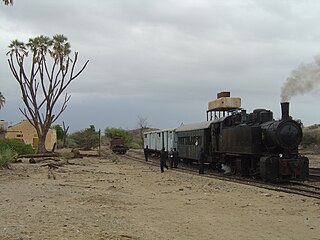
Massawa is a city on the Red Sea coast of Eritrea located at the northern end of the Gulf of Zula beside the Dahlak Archipelago. As a historical and important port for many centuries, it was ruled by a succession of polities, including the Axumite Empire, Medri Bahri Kingdom, the Umayyad Caliphate, various Beja sultanates, the Ottoman Empire, the Khedivate of Egypt, Italy, Britain, and Ethiopia, until Eritrea's independence in 1991. Massawa was the capital of the Italian Colony of Eritrea until it was moved to Asmara in 1897.

The Eritrean People's Liberation Front (EPLF) was an armed Marxist organization that fought for the independence of Eritrea from Ethiopia. It emerged in 1970 as an intellectual left-wing group that split from the Eritrean Liberation Front (ELF). After achieving Eritrean independence in 1991, it transformed into the People's Front for Democracy and Justice (PFDJ), which serves as Eritrea's only legal political organisation.

Agordat is a city in Gash-Barka, Eritrea. It was the capital of the former Barka province, which was situated between the present-day Gash-Barka and Anseba regions.

Adi Keyh is a market town in Eritrea, lying approximatively 110 kilometers southeast of Asmara. It lies almost 2,500 metres above sea level and has a population of around 40,000 people. They speak Saho, Tigrigna and Arabic languages. The ruins of Qohaito and Toconda lie near the town. Eritrea's College of Science and Arts, which cost $17 million to construct, is located in Adi Keih.

Filfil is a town in Eritrea, lying north of Asmara. Based on plantations, it is known for its surrounding rainforest and its animals. It is also within one of Eritrea's protected national forests. There is a highway built exclusively for non-commercial traffic through this town connecting the cities of Asmara and Massawa through Ghatelai.
Modern banking in Eritrea started with the arrival of the Italian colonizers. However, from 1974 on, the banking sector became a government monopoly. This situation continued after Eritrea achieved its independence. The Bank of Eritrea is the central bank of Eritrea.
The Eritrean Telecommunication Services Corporation, more commonly known as EriTel, is the sole operator of landline telephone communication infrastructure in Eritrea. It is also the sole operator of the mobile telephone service. However, it is but one of several internet service providers in the country.
The Wokiro River is a seasonal watercourse in Eritrea. It ends north of Massawa, at the Red Sea. Prior to its terminus, the Wokiro merges with the Wadi Laba River.
Logo Anseba Subregion is a subregion in the western Gash-Barka Region of Eritrea. Its capital lies at Logo Anseba.
Afabet Subregion is a subregion in the Northern Red Sea region of Eritrea. Its capital lies at Afabet.
Ghela'elo Subregion is a subregion in the Northern Red Sea region of Eritrea. Its capital lies at Ghela'elo (Ghelalo).
Ghinda Subregion is a subregion in the Northern Red Sea region of Eritrea. Its capital lies at Ghinda.
Massawa Subregion is a subregion in the Northern Red Sea region of Eritrea. Its capital lies at Massawa.
Adi Keyh Subregion is a subregion in the Debub (Southern) region of Eritrea. Its capital lies at Adi Keyh.
Central Denkalya Subregion is a subregion in the Southern Red Sea region of Eritrea. It is bordered to the northwest by the Are'eta Subregion, to the southeast by the Southern Denkalya Subregion, to the north by the Red Sea, and to the south by Ethiopia.

Southern Denkalya Subregion is a subregion in the Southern Red Sea region of Eritrea.

Dogali is a town in eastern Eritrea. Situated near Massawa, it became famous for the Battle of Dogali, on January 24, 1887, between Italy and Ethiopia.

Gura (Template:Lang-tigrnya) or Gura’e is a settlement in Eritrea's Debub region in northeast Africa. It is located in the eponymous Gura Valley in the southeastern Eritrean highlands. It is about 9 kilometers (5.6 mi) SE of Dekemhare and about 32 kilometres (20 mi) SSE of the capital Asmara.
Hadas river is the origin Adi keyih round and combine with Alighede river in wea that means in saho language flooding. It is also in the time of elf have a big role to defeat enemy.because transport is be easy to connect massawa and Adi keyih









